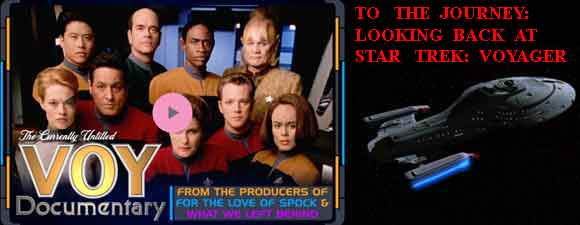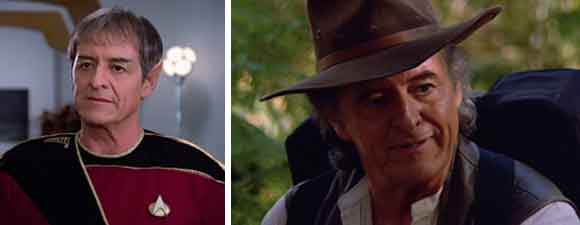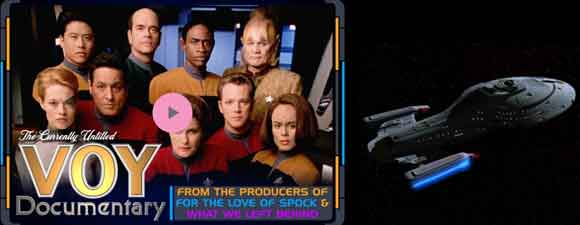Retro Review: Jetrel
6 min readThe inventor of the weapon that destroyed Neelix’s home planet seeks to cure a disease caused by exposure to the weapon.
Plot Summary: Voyager is hailed by a ship carrying a doctor named Jetrel, whom a distraught Neelix identifies as the Haakonian scientist responsible for creating the deadly Metreon Cascade, which enveloped the Talaxian moon Rinax in a deadly cloud that vaporized nearly all life. Neelix, who lost his family in the attack, wants nothing to do with Jetrel, but the scientist warns Janeway that everyone like Neelix who visited Rinax to rescue survivors is now at risk of developing a fatal blood disorder. Jetrel is hoping to test Neelix’s blood as part of his search for an antidote. Though Neelix believes Jetrel to be a genocidal monster, he agrees to permit the test in the hope of saving other lives. He makes sure to tell Jetrel about the bodies he saw and the mutilated survivors he rescued, horrors for which Jetrel agrees there can be no atonement. Privately Neelix confesses to Kes that he survived the Metreon Cascade not because he was serving in the Talaxian army as he claimed, but because he was in hiding. This makes Kes speculate that Neelix’s hatred of the scientist is actually a projection of his own guilt. Meanwhile, Jetrel deactivates Voyager’s Doctor so that he can carry out experiments in Sickbay which have nothing to do with curing the blood disorder. When Janeway discovers this subterfuge, Jetrel admits that Neelix is not suffering from the blood disorder, though Jetrel himself is dying from it. Yet that is not why Jetrel wanted to come aboard Voyager. Within the deadly particles that saturate Rinax’s atmosphere, Jetrel has been able to isolate the atomic fragments of the victims of the Metreon Cascade, and he believes that by using Voyager’s transporter, he can restore all the people vaporized in the attack. Though Tuvok is doubtful that it can work, Janeway agrees to let Jetrel make the attempt, and they nearly materialize a Talaxian before the transporter overloads and Jetrel collapses. Knowing that he can’t bring back the victims, a dying Jetrel asks Neelix whether death from the disorder he created is a fitting punishment. Neelix replies that perhaps the Cascade punished everyone involved in the war for their feelings of hatred, and forgives Jetrel just before the Haakonian dies.
Analysis: “Jetrel” is one of Voyager‘s best early episodes, pairing a substantial science fiction story with some much-needed development for a character who thus far has mostly been used for comic relief. We need to understand why Neelix is so ready to toss aside whatever life he has built in the Delta Quadrant to accompany Voyager on a one-way trip elsewhere without so much as a farewell to his family, and we need a more insightful look at the uneven courage that caused him to risk a confrontation with the Kazon to rescue Kes yet made him panic when a body-possessing alien came on board the ship. “Jetrel” is also the first indication we get of Ethan Phillips’ range as an actor, which considering how little he’s been given to do for most of the season is a wonderful revelation. The big emotional confession to Kes goes on a bit long and gets a bit preachy when Kes explains that it’s really himself and not Jetrel whom Neelix hates, but it’s nice to see that he cares for her enough to confess his greatest failing to her. It’s the scenes with Janeway that are really extraordinary, though. He has sought not just her acceptance but her approval practically since they met, and she’s put up with his quirks and weaknesses without much complaint, though she too must have been curious about precisely what motivated him apart from the need for strong allies and a wish to get away from whatever trouble he’d brought upon himself where they first met. She is understandably devastated for him when she learns what happened to his family, though she’s also enough of a Starfleet officer to insist that they hear out Jetrel when he claims to have approached Voyager on a mission of mercy to help Neelix and other Talaxians. I like the wariness with which she approaches Jetrel based on Neelix’s testimony, snapping when the scientist first mentions his studies of the transporter that he should be spending more time worrying about Neelix.
Neelix’s reactions to Jetrel evolve much like Kira’s did to the Cardassian she believed to be the Butcher of Gallitep in Deep Space Nine‘s extraordinary episode “Duet.” Believing he is facing the murderer of his people, Neelix must also confront the fact that his own cowardice kept him alive while his family died, even if he learned after the fact that the army from which he was hiding surrendered immediately upon witnessing the doomsday weapon’s effects. Jetrel at first seems terribly cold in the face of the accusations Neelix levels against him, asking about Neelix’s war record and noting that Jetrel lost his own family who saw him as a monster. He refuses to defend his wartime actions except in the name of science, which he insists in classic Vulcan fashion to be intrinsically valuable, even if the science can be used for violent ends. Jetrel admits that he developed the Metreon Cascade to see if it could be done, for he was certain that if he did not, someone else would. Some of his words echo those of Robert Oppenheimer, the Manhattan Project leader who was quoted as saying it wasn’t that he didn’t feel badly about the atomic bombing of Japan, but that he didn’t feel worse long after the fact that he felt when it took place; as Jetrel tells Neelix, “I slept no worse last night than I have any other night for the past fifteen years.” Jetrel does not quite quote the Bhagavad-Gita, “Now, I am become Death, the destroyer of worlds,” as Oppenheimer did, but he agrees with Neelix that he has become a monster. Though he’s not as insane as the original Star Trek‘s’ Kodos the Executioner, who killed a large portion of his population to save the rest from starvation, or Richard Daystrom, the inventor of the murderous M-5 computer, Jetrel is a similarly tragic figure: a visionary who thought he was helping to save his own people, who then became desperate to reverse the slaughter he unleashed.
It feels strange to say it’s a pleasure to learn that Neelix has a dark, complicated past that gives him holographic-style nightmares, and yet it’s nice to know that there’s so much more to the character than wannabe Han Solo without either the charm or wherewithal. It means more stories can be told about him like this one, which is both unpredictable and emotionally engaging, not least because this is an interesting science fiction use of a piece of technology we see practically every week for the same purpose. The transporter use looks a little like Barclay’s experience on Picard’s Enterprise trying to use the technology for a rescue, though it fails here, and if it’s a shame that we get no indication the Haakonians will continue Jetrel’s work to try to rescue their former enemies, it’s equally a shame that we never see any sort of transporter use like this again, even something in the creepy-horror-movie category where someone tries to use it to bring back a dead loved one by putting engrams into an old transporter pattern the way we’ve seen it used to age or de-age people. There are both philosophical and ethical questions attached to transporting, like whether the person who comes out is merely a copy while the “original” died upon first transport – in essence, whether sentient beings have non-reproducible souls – and whether anyone has tried to create a transporter clone like Tom Riker to harvest healthy organs after a devastating accident like Christopher Pike’s. Given UPN’s obsession in Voyager‘s early days with marketing hot women to young men, I’d expect someone to create a program where one simply beams oneself into a younger, thinner version of one’s body. Instead “Jetrel” shows us both a terrible use of science, the equivalent of using nuclear energy only to make bombs, and a wonderful use of science, the use of technology to attempt to undo the devastation of war, all wrapped in a poignant character story…the best sort of sci-fi.







“it’s equally a shame that we never see any sort of transporter use like this again, even something in the creepy-horror-movie category where
someone tries to use it to bring back a dead loved one by putting engrams into an old transporter pattern the way we’ve seen it used to age or de-age people.”
It’s been a while since I’ve seen the episode, so I might be remembering wrong, but isn’t what Jetrel tried to do basically the same as what Erickson tried to do in “Daedalus”?
Excellent review of an excellent episode!
It’s very layered and deep on so many levels, which makes it some of the best of Trek story telling. And the fact that the transporter is not the deus ex machina makes it so much better.
Overall good treatment of some delicate subjects. My rating: 7/10.
Neelix is hands-down the most annoying character in any incarnation of Star Trek, but Ethan Phillips’s nonverbal reaction (on the bridge) when Neelix realizes who Jetrel is and his nonverbal “telling” to Janeway of the loss of his family really nailed it.